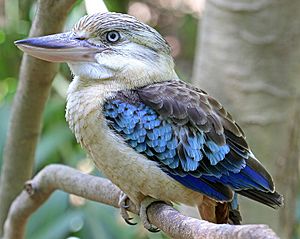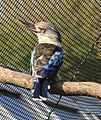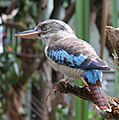Blue-winged kookaburra facts for kids
Quick facts for kids Blue-winged kookaburra |
|
|---|---|
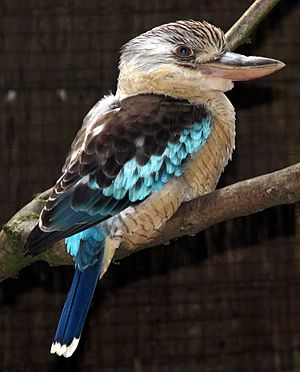 |
|
| Male | |
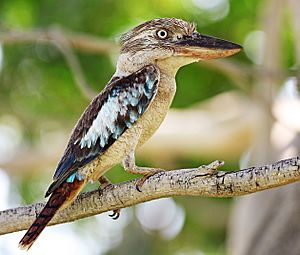 |
|
| Female | |
| Conservation status | |
| Scientific classification | |
| Genus: |
Dacelo
|
| Species: |
leachii
|
The blue-winged kookaburra (Dacelo leachii) is a large bird from the kingfisher family. You can find it in northern Australia and southern New Guinea.
This kookaburra is about 40 cm (16 in) long. That's a bit smaller than the well-known laughing kookaburra. It has creamy-white feathers on its body with brownish stripes. Its wings are blue, and its shoulders are brown. The lower back (rump) is also blue.
Male and female blue-winged kookaburras look a bit different. This is called sexual dimorphism. Males have a blue tail. Females have a reddish-brown tail with black stripes.
| Top - 0-9 A B C D E F G H I J K L M N O P Q R S T U V W X Y Z |
What is a Blue-Winged Kookaburra?
The blue-winged kookaburra is a type of kookaburra. There are four kinds of kookaburras in the Dacelo group. People sometimes call this bird the barking or howling jackass. It is also known as Leach's kookaburra.
This bird was first seen by a scientist named Sir Joseph Banks in 1770. But it was officially described much later, in 1826. Two scientists, Nicholas Aylward Vigors and Thomas Horsfield, gave it its scientific name. The name leachii honors a British zoologist named William Elford Leach.
How to Identify a Blue-Winged Kookaburra
An adult blue-winged kookaburra is usually 38 to 42 cm (15 to 17 in) long. It weighs between 260 and 330 grams.
Here's how it's different from the laughing kookaburra:
- It is a bit smaller.
- It does not have a dark mask around its eyes.
- It has more blue feathers on its wings.
- It has bright white eyes.
- Its beak is heavier.
The head and belly feathers are cream-colored with brown stripes. As mentioned, males have a blue tail, and females have a reddish-brown tail with black stripes. Young kookaburras have more brown stripes. Their eyes are mostly brown for their first two years.
The sound they make is like a loud, crazy cackle or bark!
Where Do Blue-Winged Kookaburras Live?
You can find blue-winged kookaburras in southern New Guinea. They also live in the wetter parts of northern Australia. Their range stretches from near Brisbane in southern Queensland across the Top End. They go as far down the Western Australian coast as the Shark Bay area. However, they are not found between Broome and Port Hedland in northwestern Australia.
These birds are quite common in their large habitat. Because of this, they are listed as "Least Concern" on the IUCN Red List. This means they are not currently in danger of disappearing.
Blue-winged kookaburras live in family groups. These groups can have up to 12 birds. They prefer open woodlands and swampy areas with Melaleuca trees. They also live in farmlands, like sugar cane fields.
What Do Blue-Winged Kookaburras Eat?
Blue-winged kookaburras hunt and eat many different animals. They usually catch animals that live on or near the ground.
- During the wet summer season, they eat more insects, lizards, and frogs.
- At other times, they eat arthropods like crayfish, scorpions, and spiders.
- They also hunt fish, earthworms, small birds, and rodents.
Sometimes, they even wait for insects to be scared out by bushfires. Then they quickly snatch them up!
How Do Blue-Winged Kookaburras Raise Their Young?
Blue-winged kookaburras are cooperative breeders. This means a breeding pair gets help from other birds in their group. These "helper" birds assist in raising the young.
They breed once a year, usually in late spring (September to December). Their nest is a hollow space high up in a tree. It can be about 25 m (82 ft) above the ground.
The female lays three or four white, slightly shiny eggs. Each egg is about 44 mm × 35 mm (1.7 in × 1.4 in) in size. The female sits on the eggs for about 26 days. After hatching, the baby birds stay in the nest for another 36 days.
When they hatch, chicks are pink, blind, and have no feathers. They use a special "egg tooth" on their beak to break out of the egg. Feathers start to grow by seven days old. Their eyes open around the tenth day.
Sometimes, young kookaburra chicks can be very aggressive. The oldest chicks might even kill the youngest one during the first week. Once they leave the nest, young birds need to learn how to hunt. Their parents teach them for 6 to 10 more weeks before they can find food on their own.
What Threats Do Blue-Winged Kookaburras Face?
Some animals hunt blue-winged kookaburras. These include the red goshawk and the rufous owl.
Adult kookaburras are slow flyers. This makes them vulnerable to being hit by cars on country roads. Their nests can also be raided by predators. These include olive pythons, quolls, and goannas.
Gallery
-
Male at Adelaide Zoo
See also
 In Spanish: Cucaburra aliazul para niños
In Spanish: Cucaburra aliazul para niños



